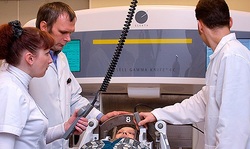 American scientists invented a new method to distinguish cancer cells. Specialized acoustic device, subjecting them to the action of sound waves and passing through tiny channels can allocate unhealthy cells. American scientists invented a new method to distinguish cancer cells. Specialized acoustic device, subjecting them to the action of sound waves and passing through tiny channels can allocate unhealthy cells.
Scientists at the scientific-technical University in conjunction with experts from the University of Carnegie Mellon University have devised a new technique to distinguish cancer cells, exposing them to the action of sound waves and watching as they pass through tiny channels. A small device can be used to detect extremely rare cells that circulate in the blood of cancer patients, and to help health workers to forerun the formation of tumors at an early stage, and whether it can spread any further.
"Sound" separation of cells is more than a simple choice of available methods of sort, which encouraged labeling of cells with chemicals or expose them to strong mechanical action. "Sound effect is considered to be the most gentle and natural way to separate cells", - quotes the words of a researcher of the Department of materials science and engineering MIT Min Tao magazine "Popular Mechanics".
Researchers tested the device on breast cancer cells, known as MCF-7, cells and leukocytes. These 2 types of cells differ in size (20 н?m in diameter for MCF-7 and 12 н?m for white blood cells), also in view of the density and compressibility. The consequence was successfully identified 71% of cancer cells.
"This method is a breakthrough in technology for the detection of circulating cancer cells in the body. It has the potential to offer not dangerous and successful new tool for health care workers and patients", says the President of the University, Carnegie Mellon SUBR Suresh.
To sort cells using sound waves scientists have adopted a microfluidic device with 2 acoustic transducers, which generate sound waves on both sides of the microchannels. When 2 sound waves meet, in the aggregate, they form a standing wave, which produces a line of low pressure, which is parallel to the direction of flow cells. Cells that are faced with this line, pushed in the direction of the channel length of moving cells is dependent on their size and compressibility.
Devices that use this principle was present before, but since there is only 1 line pressure, the cells may be relegated solely on short distances. New device solves this problem by tilting the sound wave is this normal modification significantly increases the efficiency of the process. That was enough to separate cells of different sizes without causing almost no damage.
<iframe width="560" height="315" src="//www.youtube.com/embed/wCIW4yeCf6Y" frameborder="0" allowfullscreen></iframe>
sections: Society
|